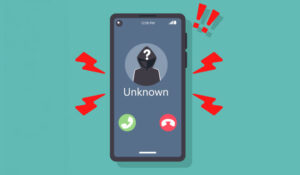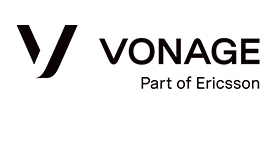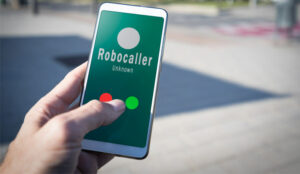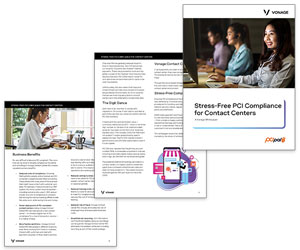Vonage discusses how to recognize, combat, and prevent caller ID spoofing to minimize the damage it can do to your business.
Can you spot a caller ID spoofing scam?
These malicious scams target businesses by disguising their caller ID and impersonating trusted sources to trick you into handing over sensitive information.
You could even find your own business phone number being spoofed by scammers to commit fraudulent activities.
So, how can you protect yourself against being a victim of caller ID spoofing?
Top Caller ID Spoofing Insights for Business Protection
- Caller ID spoofing disguises the true identity of a caller, often to impersonate trusted businesses, and is widely used in fraud and social engineering attacks.
- Scammers use methods like VoIP spoofing, spoofing services, and orange boxing, as well as advanced tactics such as SS7 exploitation and CNAM manipulation.
- Common business threats include financial fraud, supply chain scams, utility shutoff schemes, and telephony denial-of-service (TDoS) attacks.
- Prevention requires both employee training (recognizing spoofed calls, verifying identities) and technical safeguards like STIR/SHAKEN authentication, VoIP security, and branded calling.
- Rapid incident response, documenting events, alerting customers, notifying telecom providers, and regulatory reporting, is critical to limit brand damage and financial loss.
What Is Caller ID Spoofing?
Caller ID spoofing is when a caller falsifies their phone number or caller ID information to disguise their identity and make it appear as though the call is coming from someone it’s not.
Using spoofing, scammers can intentionally mask their phone number to impersonate trusted businesses that the target is affiliated with, such as financial services or government bodies. They can even change the name on the caller ID display to that of a legitimate business or person.
The ultimate goal is to trick the target into revealing sensitive information that can be used to commit fraud, such as bank account details or employee credentials.
How Does Caller ID Spoofing Work?
A caller ID spoofing scam can be executed using three different methods: VoIP spoofing, spoofing services, and orange boxing.
What Is VoIP Spoofing?
Voice over Internet Protocol (VoIP) spoofing is when a scammer signs up for a VoIP provider and changes their number to that of a trusted source.
They can also use open-source VoIP tools to achieve the same result for free. This is the most common technique used by scammers to falsify their phone number, as almost every phone number can be spoofed.
What Are Spoofing Services?
Spoofing services serve a specific, nefarious purpose – to allow scammers to obtain spoofed numbers on demand.
Some spoofing services work similarly to a prepaid credit card, while others operate via free, web-based platforms.
But essentially, they all enable scammers to enter any caller ID information they want, and the service will transfer the call to the target with the scammer’s chosen caller ID displayed. As this method requires no tech skills or equipment, it’s a popular, easy choice for scammers.
What Is Orange Boxing?
Orange boxing works slightly differently. It uses a piece of hardware or software known as an “orange box” to imitate the audio signal of an incoming call and replace the caller ID display.
This method is used to trick targets into thinking that they’re being contacted. It’s a devious tactic used by scammers to execute sophisticated social engineering scams.
Advanced Spoofing Methods Businesses Should Know
While VoIP spoofing, spoofing services, and orange boxing are common, attackers targeting businesses also use advanced techniques that bypass basic defenses:
- SS7 network exploitation: By gaining unauthorized access to the Signaling System 7 (SS7) network — the system that connects telephone exchanges worldwide — attackers can spoof numbers at the carrier level. This method is harder to detect and block, and often requires cooperation from telecom providers to mitigate.
- Caller Name (CNAM) manipulation: Instead of displaying your company name, spoofers may replace it with a location (“CALIFORNIA,” “ONTARIO”) or slightly alter the spelling of a brand name to trick recipients.
- Direct SIP/ENUM routing exploits: If your business VoIP numbers are accessible via open SIP addresses or ENUM records, attackers can bypass PSTN checks entirely and reach targets with spoofed caller IDs.
These methods require more sophisticated technical defenses, making close coordination with your telecom provider essential.
How to Spot Spoofed Calls
Even the most convincing fake calls leave clues. Watch for these red flags:
- Mismatched contact details: The name is familiar, but the number doesn’t match your saved contact.
- Neighbor spoofing: The number uses your area code and prefix to appear local.
- Urgency or threats: The caller claims immediate action is needed to avoid penalties, arrest, or account loss.
- Unexpected prerecorded messages: You’re prompted to press buttons or confirm personal information.
- Slight variations in name spelling: “David” vs. “Dave” for the same contact.
If any of these occur, hang up and verify by calling the official number from a trusted source.
The History of the Scam: From Early Days to Caller ID Spoofing Online
For as long as telephones have been around, so have telephone scams. But it used to be much easier to scam people before caller ID became publicly integrated into landlines in the 1980s. Before that, you simply had to trust that the person on the other end of the phone was who they claimed to be.
When caller ID became a common telephone feature in the 80s, scammers were forced to manipulate the telephone network to spoof numbers.
This required in-depth technical knowledge and access to expensive telephony equipment, so it was only employed by seasoned con artists. As a result, spoofing was a lot less common.
That is, until the internet and VoIP exploded onto the scene.
VoIP empowers you to make calls over the internet via your computer. This comes with significant benefits that continue to revolutionize communications today — enhanced flexibility, scalability, cost-effectiveness … the list goes on. But it also gave rise to easier number spoofing capabilities.
Using VoIP technology and spoofing services, scammers can impersonate legitimate phone numbers as many times as they want, with minimal technical skills.
They can change the location, name, and other ID information to trick victims into thinking that they’re receiving a legitimate call from a trusted source.
This has caused phone spoofing to become more prevalent and, with it, imposter scams have skyrocketed.
According to newly released Federal Trade Commission data that explores the losses generated from fraud, imposter scams were the most commonly reported by consumers and incurred losses totaling $2.95 billion in 2024.
And of all the contact methods used by scammers, the phone was the second-highest channel after email.
Luckily, the advantages of VoIP far outweigh the cons. And there are measures you can take to mitigate the risk of spoofing for your business, employees, and customers.
Why Do Scammers Spoof a Caller ID or Number?
Scammers that target businesses have one goal in mind — to access your money and/or sensitive business information.
However, fewer people than ever will answer a call from a number that they don’t recognize. It’s why so many businesses use branded calling, which provides the receiver of the call with trusted brand signifiers, such as the company name, business phone number, and logo, which improves answer rates.
Scammers know this, which is why they’ve turned to caller ID spoofing.
Spoofers can trick you into thinking you’re being contacted by a legitimate business by using a fake version of their number to call you. Once they’ve gained this trust, they manipulate you into handing over sensitive details.
Let’s say that a scammer decides to pose as a reputable supplier. They spoof the supplier’s number and call a member of your procurement team, who sees this trusted supplier’s number and caller ID on their incoming call display screen.
Thinking that it’s the supplier, the employee will pick up the phone — phase one of the scam is completed.
From there, the scammer will pretend to be a company representative. They’ll deploy sophisticated scam scripts and manipulation tactics, such as telling you that your recent payment declined or that they urgently need to verify some details.
Using the trust they gained by caller ID spoofing, the scammer can deceive the employee into revealing sensitive information (bank account details, credit card details, customer records, employee credentials, etc). They might also employ other tactics to improve their chances, such as deep-fake audio.
Of all business industries, the financial sector is most targeted by fraud, including caller ID spoofing. It’s commonly used to initiate authorized push payment (APP) fraud.
This is a scam where an employee is tricked into transferring large funds into a bank account held by a fraudster posing as a legitimate payee.
To put this into perspective, APP fraud was rated the most frequent type of fraud case experienced by financial services, at 22%, according to Alloy’s 2024 State of Fraud Benchmark Report, where they surveyed over 400 financial services experts who worked in fraud-related departments.
The Most Common Spoofing Scenarios Your Business May Encounter
Beyond financial fraud, businesses have reported these high-risk spoofing tactics:
- Utility shutoff threats: Scammers impersonate utility providers and demand immediate payment to avoid service disconnection, a common ploy against manufacturing, healthcare, and hospitality sectors.
- Government or regulator impersonation: Fraudsters pose as tax agencies, licensing boards, or compliance auditors to extract sensitive data.
- Telephony Denial-of-Service (TDoS) attacks: By flooding your lines with spoofed calls, attackers can block legitimate inbound communication, affecting sales, support, or emergency response.
- Real-world example of TDoS attack: In one documented incident, a regional hospital’s phone lines were overwhelmed by thousands of spoofed calls over several hours, preventing patients from reaching emergency services and disrupting internal coordination. Attackers had spoofed the hospital’s own number to flood inbound lines, a tactic that can be equally damaging for corporate contact centres and critical business operations.
- B2B supply chain fraud: Spoofers imitate your suppliers or customers to place fraudulent orders, reroute shipments, or alter payment details.
Training your staff to recognize these scenarios is just as important as having technical safeguards in place.
How to Recognize and Combat a Caller ID Spoof
Scammers will try and impersonate anyone that they can. Business partners, banks, company directors, insurers, clients, suppliers, CEOs — nobody is off-limits.
Fortunately, there are some strategies you can use to prevent and detect caller ID spoofing to protect your business.
Double-Check the Caller ID
Is the display name slightly different from the name saved in your contacts (e.g., Pete Jones instead of Peter Jones)? Or do you recognize the caller ID display name but not the number they’re calling from?
If so, it’s probably a scam. Check that the phone number the person is calling from matches the one in your contacts and/or the number on their official business contact page.
Be Naturally Skeptical of Unexpected and Unsolicited Calls
Caller ID spoofing detection often involves using your better judgment. Be cautious of unexpected calls from anyone that you haven’t had recent contact with, especially if they’re asking for sensitive details or payment. Be wary of callers who use generic greetings instead of addressing you by your first name, too.
And most importantly, never divulge sensitive information if the call feels even the slightest bit suspicious.
Use a Business Phone System That Offers Spam Protection
For enterprise-grade caller ID spoofing protection, use a solution like Vonage Spam Shield. This powerful feature screens incoming calls by matching them against numbers associated with telemarketing, robocalls, and scams. Suspicious calls are marked as “Suspected Spam” on your display, allowing you to decline the call.
Be Suspicious of “Sense of Urgency” Requests
Scammers like to create a sense of urgency to instill stress or panic, which clouds your judgment and drives immediate action.
For example, a scammer might tell you that your business account has been hacked and you need to act quickly to prevent consequences, causing you to panic and divulge sensitive details.
Be Aware of Robocalls
Just like businesses, scammers have access to interactive voice response systems — except here, they’re used for nefarious purposes.
If you answer the phone and are greeted by a pre-recorded message that’s telling you to follow instructions or press specific numbers (e.g., “press 1 for yes and press 2 for no”), hang up immediately.
Hang up and Call Back
If you’re being asked for sensitive details and are in any way suspicious, one of the best ways to detect a spoofed caller ID is to simply hang up the phone and call it back. Never just redial the number — go to your contact list or find the number on an official business site and make a new call.
This way, you’ll reach a genuine person or business who will be able to confirm or deny the legitimacy of the earlier call.
Educate Your Employees
Educating your employees is one of your biggest defenses against fraud trends, caller ID spoofing included. Hold training sessions that go over the ways to combat fraud.
Stress how important it is that employees exercise vigilance and refrain from handing over sensitive information before verifying the identity of the caller.
Secure Voicemail Accounts
Ensure that all business voicemail systems, especially for executives, sales, and customer-facing staff, are protected with strong passwords.
Some services allow voicemail access when a call originates from the user’s own number, which spoofers can exploit. A password requirement blocks this common loophole.
While these measures help employees handle spoofed calls in real time, businesses also need system-wide safeguards and compliance strategies to prevent spoofing at its source.
Enterprise Caller ID Spoofing Risk Management
Caller ID spoofing can hurt more than just your phone system, it can damage your brand, reduce answer rates, and even expose you to regulatory penalties.
While front-line employees need to know how to spot spoofed calls, business decision-makers and IT teams must take broader, system-wide measures to prevent their numbers from being misused.
The following steps are designed for business operations, IT security, and compliance leaders to protect outbound calling integrity and customer trust.
1. Confirm STIR/SHAKEN Authentication Across All Business Lines
Work with your telecom provider to ensure FCC-mandated STIR/SHAKEN call authentication is fully enabled for your VoIP and PSTN lines.
- Request call attestation reports to verify your outbound calls are trusted by other carriers.
- Higher attestation levels can improve customer answer rates and reduce “spam” labeling.
While STIR/SHAKEN greatly improves trust in caller ID, it only applies to calls carried over IP networks. Any calls traversing non-IP segments require additional mitigation measures.
The FCC also mandates that businesses originating outbound calls maintain a robocall mitigation plan and, in some cases, register in the Robocall Mitigation Database.
Even if your provider is compliant, you may be asked to provide documentation during vendor audits or partnership negotiations.
2. Secure Your VoIP and PBX Infrastructure
Unprotected business phone systems can be exploited to originate spoofed phone numbers in your name.
- Encrypt SIP traffic and voice streams.
- Keep PBX/VoIP firmware and software updated.
- Limit international dialing to approved users.
- Use IP allow lists to control which devices can place calls.
3. Create a Customer Alert & Verification Protocol
If scammers spoof your business number, fast, clear communication limits brand damage.
- Provide customer service teams with scripts for handling spoofing complaints.
- Post alerts on your website and social media if spoofing incidents are active.
- Share official contact numbers customers can use to verify legitimate calls.
4. Register and Brand Your Caller ID
Increase customer trust by making your outbound calls easily recognizable.
- Register numbers with the Free Caller Registry used by major U.S. carriers.
- Ask your telecom provider about branded calling (CNAM with company name/logo).
5. Monitor Your Outbound Call Reputation
Third-party analytics tools can detect unusual call patterns or reputation drops.
- Monitor your numbers with Neustar, Hiya, or First Orion.
- Investigate spikes in complaints or sudden “spam” labels.
6. Maintain FCC-Compliant Robocall Mitigation Practices
If you originate outbound calls, you may be required to have a documented robocall mitigation plan.
- Keep detailed logs of outbound call origins and caller ID settings.
- Work only with carriers who comply with FCC authentication rules.
- Review and update your plan annually.
7. Protect Your Brand and Choose the Right Telecom Partner
If your business number is repeatedly spoofed, you risk:
- Lower customer answer rates due to “spam” labeling on outbound calls
- Potential blacklisting by carriers
- PR or legal fallout if spoofed calls are recorded and misused
Vet telecom vendors for strong caller ID authentication controls. Avoid wholesale VoIP providers that allow unrestricted caller ID changes, as they are a common source of spoofing abuse.
Partnering with a provider that actively monitors and reports suspicious activity can reduce your risk. Employee awareness is essential, but it’s not enough.
By combining technical safeguards, compliance planning, and proactive customer communication, your business can reduce the risk of caller ID spoofing while protecting brand reputation and call answer rates.
Global Caller ID Spoofing Regulations Businesses Must Follow
If your company operates internationally, compliance with spoofing-related laws varies by jurisdiction:
- Canada (CRTC): Requires telecoms to implement STIR/SHAKEN and block calls with invalid caller IDs. Noncompliance can result in enforcement actions.
- United Kingdom (Ofcom): Businesses must use “presentation numbers” they own or have permission to use. Violations can lead to fines up to £2 million.
- India (DOT): Spoofing is a criminal offense, with penalties including fines and up to three years in prison.
Ensure your outbound call practices align with each market’s regulations, especially if you use international contact centres or VoIP services.
How to Stop Caller ID Spoofing
If your business number is being spoofed, a fast and coordinated response can limit the damage to your brand, restore customer trust, and reduce the operational impact.
- Document the incident: Log the date, time, and nature of reports, capture any call recordings, and note the affected numbers.
- Notify your telecom provider: Ask them to investigate and, if possible, trace and block the spoofed traffic.
- Inform customers promptly: Post alerts on your website, social media, and customer portals explaining the situation. Include guidance to never share sensitive information over the phone.
- Report to regulators: File a complaint with the FCC in the U.S. or your country’s equivalent authority if operating internationally.
- Increase call monitoring: Temporarily review call logs more closely for spikes in suspicious traffic or unusual patterns.
Being on the receiving end of a spoofed call is bad enough — but having your own number spoofed can cause serious reputational harm. If customers and contacts don’t trust that your calls are genuine, they may choose to stop engaging with your business altogether.
Long-term prevention measures:
- Limit public exposure of work phone numbers: Reduce the chance of compromise by training employees not to post work numbers on public sites or online forms.
- Reinforce branded calling: Use solutions like Vonage Branded Caller ID to display your company name, logo, and call reason on outbound calls to increase recognition and trust.
- Ensure STIR/SHAKEN compliance: Partner with a provider that supports FCC-mandated call authentication. This increases the likelihood that spoofed versions of your number will be flagged or blocked before reaching recipients.
- Educate your team and partners: Include spoofing awareness in employee and partner training, emphasizing verification before sharing any sensitive information.
By combining rapid incident response with proactive measures, you can protect your outbound calling integrity, minimize disruption, and safeguard customer confidence in your brand.
This blog post has been re-published by kind permission of Vonage – View the Original Article
For more information about Vonage - visit the Vonage Website
Call Centre Helper is not responsible for the content of these guest blog posts. The opinions expressed in this article are those of the author, and do not necessarily reflect those of Call Centre Helper.
Author: Vonage
Reviewed by: Jo Robinson
Published On: 30th Sep 2025
Read more about - Guest Blogs, Vonage






 Vonage is redefining business communications, helping enterprises use fully-integrated unified communications, contact centre and programmable communications solutions via APIs.
Vonage is redefining business communications, helping enterprises use fully-integrated unified communications, contact centre and programmable communications solutions via APIs. 


































